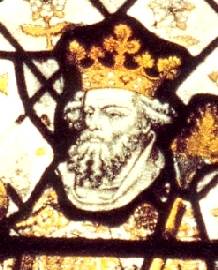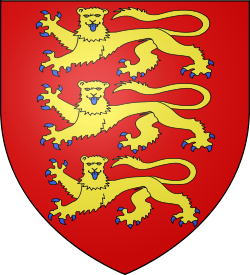Edgar the Peaceful
| Edgar the Peaceful | |
|---|---|
| King of England | |
 |
|
| Reign | 1 October 959–8 July 975 |
| Predecessor | Edwy |
| Successor | Edward the Martyr |
| Spouse | Æthelflæd, Wulfthryth and Ælfthryth |
| Issue | Edward the Martyr Ethelred the Unready |
| Father | Edmund I |
| Mother | Elgiva |
| Born | 943/944 Wessex, England |
| Died | July 8, 975 Winchester, Wessex, England |
| Burial | Glastonbury Abbey |
| Military Service | |
| Rank | 13th |
Edgar I the Peaceful or the Peaceable (c. 7 August 943–8 July 975) was a king of England.
Edgar was the younger son of Edmund I of England. His cognomen, "the Peaceable", was not necessarily a comment on the deeds of his life, for he was a strong leader, shown by the seizure of the Northumbrian and Mercian kingdoms from his older brother, Edwy, in 958. Edgar was held to be king north of the Thames by a conclave of his nobles, and the aspirational ruler set himself to succeed to the English throne. With Edwy's death in October 959, Edgar immediately recalled Dunstan (eventually canonised as St. Dunstan) from exile to have him made Bishop of Worcester (and the Bishop of London after, and finally the Archbishop of Canterbury). The allegation Dunstan at first refused to crown Edgar because of disapproval for his way of life is a discreet reference in popular histories to Edgar's mistress, Wulfthryth (later a nun at Wilton), who bore him a daughter Eadgyth. Dunstan remained Edgar's advisor throughout his reign.
Edgar's reign was a peaceful one, and it is probably fair to say that it saw the Anglo-Saxon kingdom of England at its height. Although the political unity of England was the achievement of his predecessors, it was Edgar who saw to its consolidation. By the end of Edgar's reign there was practically no likelihood of any recession back to its state of rival kingships, and the division of its domains.
The Monastic Reform Movement that restored the Benedictine Rule to England's undisciplined monastic communities saw its height during the time of Dunstan, Aethelwold and Oswald. However, the extent and importance of the movement is still debated amongst academics.
Edgar was crowned at Bath, but not until 973, in an imperial ceremony planned not as the initiation, but as the culmination of his reign (a move that must have taken a great deal of preliminary diplomacy). This service, devised by Dunstan himself and celebrated with a poem in the Anglo-Saxon Chronicle forms the basis of the present-day British coronation ceremony. The symbolic coronation was an important step; other kings of Britain came and gave their allegiance to Edgar shortly afterwards at Chester. Six kings in Britain, including the kings of Scotland and of Strathclyde, pledged their faith that they would be the king's liege-men on sea and land. Later chroniclers made the kings into eight, all plying the oars of Edgar's state barge on the River Dee. Such embellishments may not be factual, but the main outlines of the "submission at Chester" appear true.
Edgar had several children. He died on 8 July 975 at Winchester, and was buried at Glastonbury Abbey. He left two sons, the eldest named Edward, the son of his first wife Ethelfleda (not to be confused with Ethelfleda, Lady of the Mercians), and Ethelred, the youngest, the child of his second wife Ælfthryth. He was succeeded by his eldest son, Edward.
From Edgar’s death to the Norman Conquest there was not a single succession to the throne that was not contested. Although perhaps a simplification, Edgar’s death did seem to be the beginning of the end for Anglo-Saxon England that resulted in three successful 11th century conquests, two Danish and one Norman.
Genealogy
For a more complete genealogy including ancestors and descendants, see House of Wessex family tree.

1. Biography
External links
- Medieval Sourcebook: Anglo-Saxon Dooms: laws of King Edgar, a fragment
- Edgar of England At Find A Grave
- Oxford Dictionary of National Biography entry
| Preceded by Edwy |
King of England 959–975 |
Succeeded by Edward the Martyr |
|
|||||||||||
